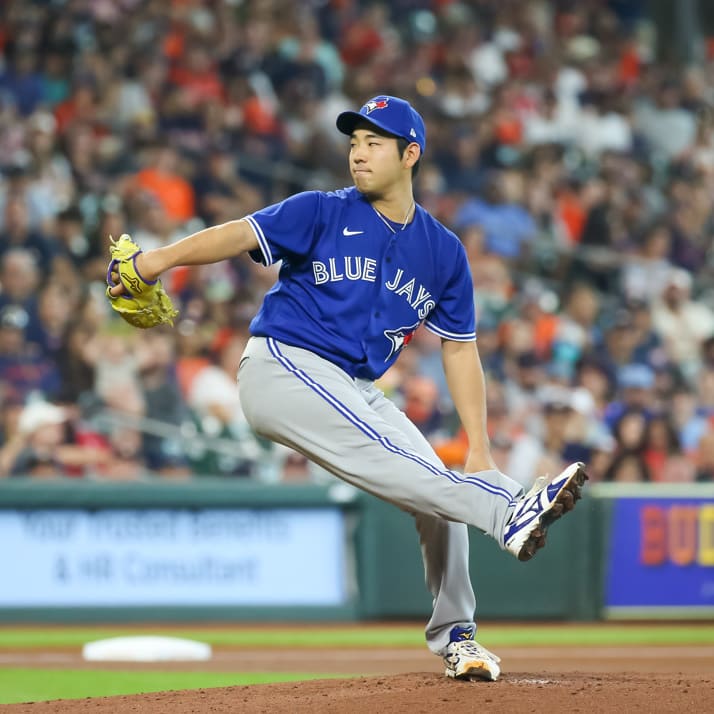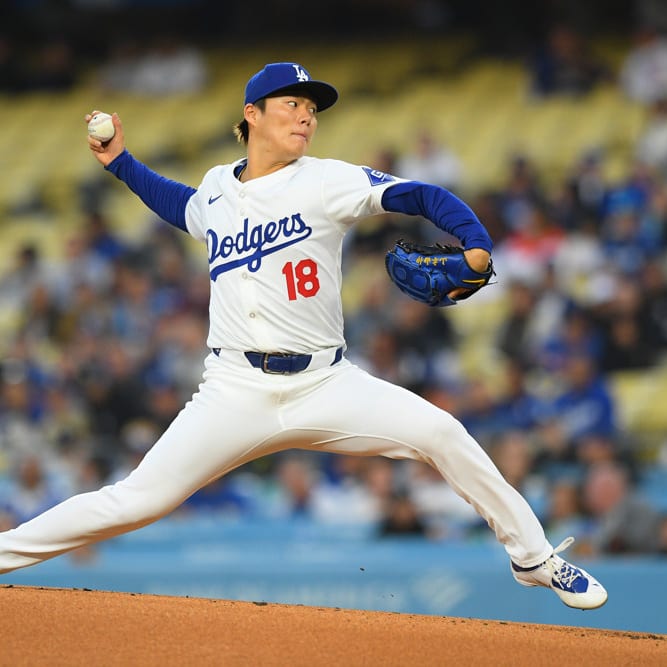This article is part of our Scouting Pitchers series.
The Padres have been the biggest surprise in baseball, holding the lead in the NL West far longer than expected. They have done so without Chris Young, their highest-paid player, who has been shelved by shoulder problems all season. San Diego's staff is not a Petco Park fluke – their 3.66 road ERA is third-best in the majors, just 0.02 off Cincinnati's 3.64. The Padres' 2.90 home ERA is fourth-best in the majors, while their overall 3.26 ERA is tops.
I gave a quick look at Mat Latos in last week's column and gave props to his stuff – mid-90s fastball and two breaking balls. Latos came off the DL and pitched well on July 24 after missing a couple of starts with an oblique strain. Just 22, Latos is primarily a fastball-slider pitcher, but his fastball has great movement and his slider has a curveball's depth. He does a good job of pitching downhill.
Although his curveball isn't his go-to pitch, hitters seem surprised when Latos uses it. Latos will also pop his 83-84 mph changeup in there unpredictably. He's efficient (15.5 P/IP) and the umpires seem to give him a big zone. I don't see red flags in Latos' delivery, although he could use his lower half more. It's hard not to forecast his continued success.
Clayton Richard has struggled in July (7.13 ERA) after posting ERAs of 3.00 or below in each of the first three months. His fastball sits at 92-94 consistently and he has
The Padres have been the biggest surprise in baseball, holding the lead in the NL West far longer than expected. They have done so without Chris Young, their highest-paid player, who has been shelved by shoulder problems all season. San Diego's staff is not a Petco Park fluke – their 3.66 road ERA is third-best in the majors, just 0.02 off Cincinnati's 3.64. The Padres' 2.90 home ERA is fourth-best in the majors, while their overall 3.26 ERA is tops.
I gave a quick look at Mat Latos in last week's column and gave props to his stuff – mid-90s fastball and two breaking balls. Latos came off the DL and pitched well on July 24 after missing a couple of starts with an oblique strain. Just 22, Latos is primarily a fastball-slider pitcher, but his fastball has great movement and his slider has a curveball's depth. He does a good job of pitching downhill.
Although his curveball isn't his go-to pitch, hitters seem surprised when Latos uses it. Latos will also pop his 83-84 mph changeup in there unpredictably. He's efficient (15.5 P/IP) and the umpires seem to give him a big zone. I don't see red flags in Latos' delivery, although he could use his lower half more. It's hard not to forecast his continued success.
Clayton Richard has struggled in July (7.13 ERA) after posting ERAs of 3.00 or below in each of the first three months. His fastball sits at 92-94 consistently and he has hit 95-96. That pitch also has some cutting movement. Richard complements his 81-85 mph slider with a nice 83-84 mph changeup. The change has been crucial, as it is a marked contrast to his other stuff. Richard has kept the ball down (1.02 G/F, 13 GIDP) and greatly improved his efficiency (15.9 P/IP).
Despite the positives, Richard's motion looks more like a reliever's than a 200-inning starter's. He relies a lot on his arm, as he doesn't get low to the ground during his drive. Richard works quickly, which is normally an asset, yet he doesn't quite have the moxie to pitch his way through jams by instinct. As someone who isn't free and easy, he can lose command of his curve and changeup. I'm encouraged by Richard's 2010 success, but he still has work to do.
Jon Garland doesn't top 91 mph any more, but he has refined his 79-83 mph changeup and 77-81 mph curveball. Garland can also cut the ball a little into both right- and left-handers, and he throws an 81-86 mph slider. Garland always did the little things, as he has a nice delivery and fields his position. He hasn't been as efficient this year (16.7 P/IP) as he has been in his career, but Garland's other peripheral numbers are right about at his career norms, although his strikeout rate (5.84/9 IP) has risen.
Wade LeBlanc has kept hitters guessing by moving his 86-89 mph fastball to both sides of the plate. His 73-78 mph changeup has some good fade, and he has a 75 mph curveball. LeBlanc also has a 78-81 mph slider. He has been helped by good defense this year, and has buckled down with RISP (.221 BAA). A polished left-hander from a good college program (Alabama), LeBlanc is a safer bet than someone his age (25) who was drafted out of high school. Still, I wouldn't count on him having this type of success in 2011. LeBlanc has the moxie to be a fourth starter, but I doubt he'll rise above that. His stuff is a little short, even for a left-hander. He is not very efficient (16.5 P/IP), and as a fly ball pitcher (0.62 G/F), LeBlanc doesn't have much margin for error.
Last year's breakthrough, Kevin Correia, has stabilized this month after a dreadful June (7.83 ERA). Correia lost his brother in May, so our condolences to him. Correia has average stuff, with an 88-92 mph fastball to go with a curve and slider. Correia's across-the body, max-effort delivery isn't consistent with someone who throws more than 100 effective innings a year. His 17.6 P/IP is ominous. Correia would be an excellent sixth starter, but he is starting to be exposed in 2010.
The Padres were prescient when they refused to deal their closer, Heath Bell. Bell was the staff's lone All-Star representative, which I agree with. None of the Padres starters have had overpowering seasons, and I don't like the recent fad of making middle relievers into All-Stars. If they were good enough to be All-Stars, they'd be closers on their own teams, right?
Bell is notorious for pitching with a lot of fire and has the 93-96 mph fastball to back it up. His 80-83 mph slider has a sweeping break. Bell hides the ball and seems to jump at the hitter. He is a classic late bloomer, and as a result seems hungrier than your average 32-year-old. Bell's downside is his high pitch counts (18.4 P/IP) and his aforementioned delivery, which isn't effortless. These shouldn't be a factor in 2010. Still, which will come first for Bell – an NLCS appearance or an elbow surgery? Stay tuned.
San Diego has been able to shake the tree for what seems like a dozen arms to back up Bell. The top two are Luke Gregerson and Edward Mujica. Gregerson has combined a sinking, running 90-92 mph fastball with a low-80s slider to hold hitters to a .145 average. The movement on Gregerson's fastball is impressive, and hitters don't pick up his slider until it's too late. Gregerson helps himself out by throwing strikes and saving his bullets (14.0 P/IP). The Cardinals probably regret trading him for Khalil Greene. Another late bloomer at 26, Mujica toiled for several years in the Cleveland system before blossoming in the Padres' bullpen. Mujica throws up to 93 mph with an 83 mph slider. He has also been using a split-fingered fastball this year. Mujica has walked just one of the one hundred right-handed batters he has faced in 2010.
The Padres' top pitching prospect, Simon Castro, resembles Jose Contreras with his delivery and stuff – a low-90s fastball and good slider. Castro started the Futures Game for the World Team, but gave up two runs and threw two wild pitches. His delivery also reminded me of Justin Masterson. Both throw across their bodies, but both are still sound. I'm enthusiastic about Castro's future, but I also like Masterson probably more than I should. Castro has been rumored to be trade bait to help the struggling Padres offense, which has been as bad as a contender's can be.
Besides Adrian Gonzalez (.917 OPS), San Diego does not have a player with over 300 plate appearances with an OPS over .700. Chase Headley has a .696 OPS in 387 at-bats. There isn't immediate help on the horizon, as Triple-A Portland is bereft of hitting prospects. Double-A San Antonio has 2B Logan Forsythe (.747 OPS), SS Drew Cumberland (.632 OPS at Double-A after a .946 OPS in Class A) and 3B James Darnell (.687 OPS), all of whom need a couple more years.
Do the Padres have enough for 2010? Probably not. Yet they certainly believe in themselves. Despite their lack of multi-talented, flashy players, they'll be interesting to watch down the stretch. The Padres play as much like a college team, in terms of intensity and situational hitting, as you're likely to see in the major leagues. They are the classic underdog.









